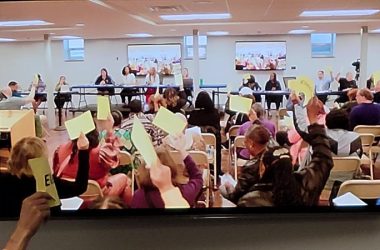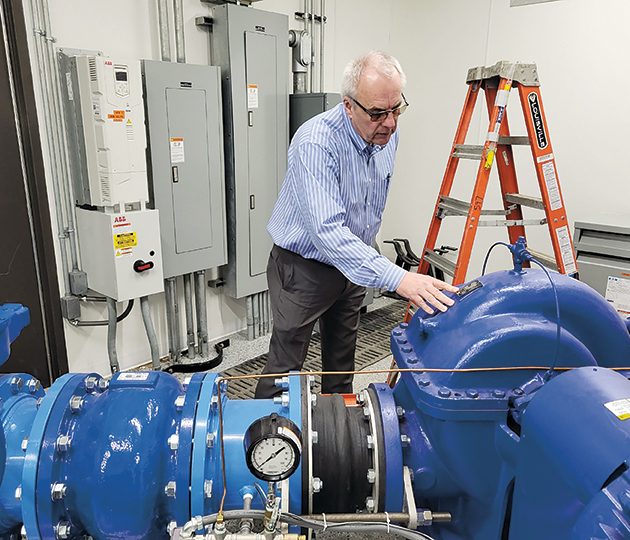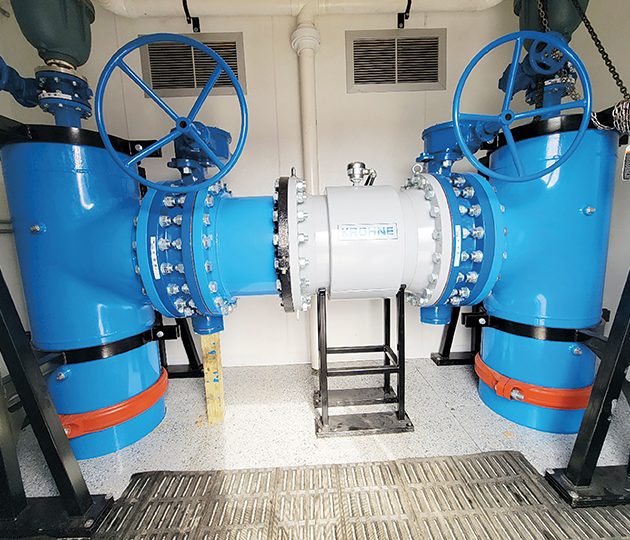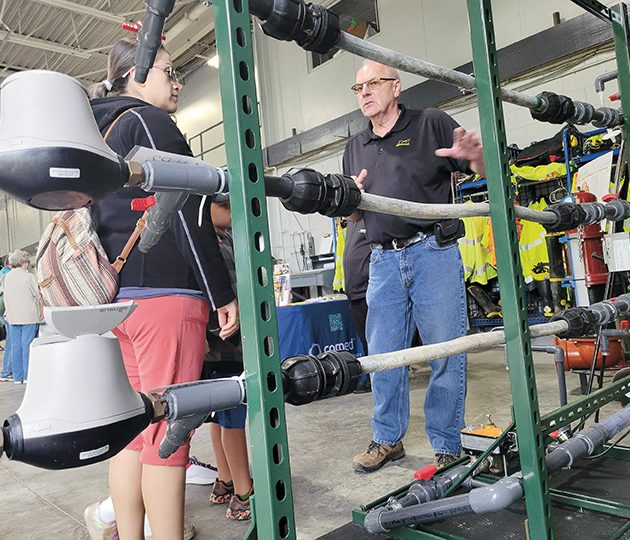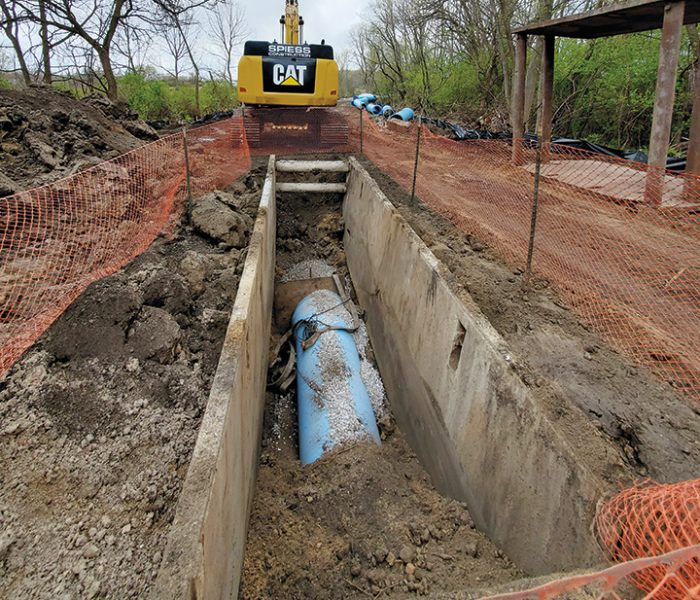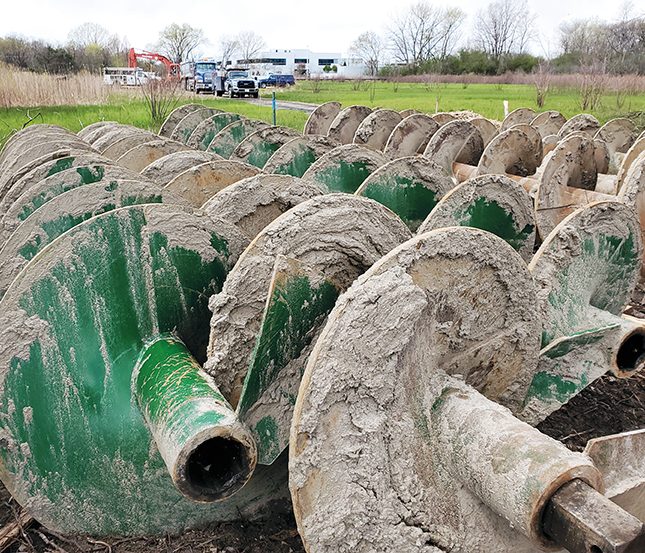In the Homewood Public Works office there is a computer with displays that show the status of the village’s water system. In a few weeks, Homewood Public Works staff will click a few buttons at that console starting the transition from the current water lines to a new set of pipes.
The new water delivery system has been under construction since it was authorized by the village board in November 2020.
While the system is new, the water will be the same.
Homewood has been buying water from the city of Harvey for nearly 40 years after residents approved a referendum to switch from well water to Lake Michigan water. Chicago is the source of Harvey’s Lake Michigan water.
When the new system is fully operational, Homewood will be purchasing water from Chicago Heights, which gets its water from Hammond, Indiana. Hammond also draws its water from Lake Michigan.
There is a slight difference in the treatment process, according to Homewood Public Works Director John Schaefer. Chicago uses a blended polyphosphate additive. Hammond uses zinc orthophosphate. Both serve the same purpose, creating a coating in service lines that prevents lead from leeching into the water.
In mid-June, Schaefer said most tests of the new Homewood delivery system were complete and that a last task, disinfecting the mains, was under way. The final step will be to receive an operating permit from the Illinois Environmental Protection Agency.
He said the village has worked closely with IEPA throughout the development of the new system, and he does not anticipate any problems with permit approval.
When the permit is received, the village will begin the transition by adding water from the new system. The first stage will supply 25% of water volume from Chicago Heights and 75% from Harvey. Water samples taken from customers will be tested. If results are good, the proportion will be moved to 50/50 and then to 75/25.
Each stage is expected to take several weeks.
If the new system passes tests at every stage, the system will go to 100% Chicago Heights water, probably by October.
Schaefer said the village has been methodical in developing the system, with safety as its primary concern. In order to test for lead and other water quality issues, the village has used a loop test using pipes taken from Homewood’s existing system.
“We’ve taken probably 20,000 samples,” he said.
If there is any doubt about the quality of water flowing through the new system, the transition will stop, so any problems can be assessed and remedied.
Water project ‘Key‘
Village officials have maintained a webpage devoted to answering residents’ questions and concerns about the project at bit.ly/homewoodwaterinfo. For anyone who has questions that aren’t answered there, the page includes a form for asking questions.
Before the transition begins, the village also mailed information to every residence and business in an effort to inform those residents who might not be likely to use digital sources of news.
Village Manager Napoleon Haney said the information would be in a magazine format similar to the quarterly Village Key publication that residents are used to seeing, but this edition will be devoted to informing residents about all aspects of the water project.
Haney said residents should have receive a copy in the mail on or about July 1. Anyone who hasn’t receive one by now should check at Village Hall, 2020 Chestnut Road, where there are extra copies available.
Why switch?
The switch to a new water provider was authorized in November 2020, but the lead-up to the project goes back much further. Finance Director Dennis Bubenik said the water source issues goes back at least 22 years.
“When I came in 2000, it was the big issue,” he said.
At that time, the village was negotiating a new contract with Harvey, and there were some officials who advocated seeking another provider. Eventually, an agreement was reached with Harvey and a new contract was signed.
But the issue didn’t subside for long. Two factors emerged in the past 10 years that resurrected concerns about the partnership with Harvey: rate hikes and system deterioration.
Starting in 2012, Chicago initiated a series of rate increases that passed through to Homewood. In 2012, the rate went up 25%; in 2013, 15%; in 2014, 15%; and in 2015, 15%. Each increase was significant in itself, but cumulatively, they were a cause for real concern to village officials, according to Bubenik.
Not all the cost of each increase was passed along to Homewood water customers, he said, but officials worried that future hikes might force the village to increase rates more dramatically.
The new contract with Chicago Heights was drawn up with rate stability as a goal. The costs the village pays during the 20-year period of the contract can go up, but the increases are tied to the cost of living index and include a cap of no more than 3%.
As Chicago water rates were going up, so was concern about the future reliability of Harvey’s water system.
Harvey’s financial woes contributed to its failure to keep current on payments to Chicago. At one point, Harvey owed Chicago about $20 million for water it purchased. The city’s financial problems led Homewood officials to worry that Harvey might not be able to properly maintain its system, which could threaten the reliability of Homewood’s source of water.
In 2014, Homewood commissioned a study of Harvey’s water system, and engineers with Baxter & Woodman Consulting Engineers reported that some of the city’s water infrastructure was in good shape but there were aging facilities, too, and some that were in poor condition.
Village officials were not reassured by the result.
In 2017, the control of the Harvey water department finances was given to a receiver after a judge found the city had failed to live up to previous agreements to pay its debts to Chicago.
In late 2018, the village commissioned studies to examine the rates Harvey was charging and to explore the feasibility of shifting to another provider, a process that eventually led to the decision to switch to Chicago Heights.
Groundwork
While concern about rates and reliability were growing, Schaefer started looking for opportunities that might give the village more options.
When an abandoned railroad line that once served the quarry in Thornton became available more than a decade ago, Schaefer proposed the village acquire it.
The old tracks ended up serving as the route for the new water line, which taps into the Chicago Heights main that runs along Indiana Avenue.
The village purchased more land on 183rd Street just west of the Chicago Heights water line, and that’s where the new pump station was built. There is enough unused space there to accommodate expansion of facilities if future use increases.
Schaefer said Homewood has been selling water to Flossmoor for many years and will continue to do so. East Hazel Crest is considering buying water from Homewood.
Izaak Walton
The acquisition of the old railroad line helped make the project possible, but it also created a cause for concern among some nature lovers in the community. The new line runs through Izaak Walton Nature Preserve.
Horizontal boring under prairie land on the west side of the preserve mitigated the impact some, but the surface excavation through woodlands was dubbed “the path of destruction” on local social media.
“We tried to save as many trees as we could,” Schaefer said.
He said the path of the water line had been seeded with prairie plants, but it will take some time for new growth to get established.
“In a couple years, once growth starts happening, you won’t even know it. Nothing’s had a chance to grow yet.”
Paying cash
The project cost is nearly $12 million, but the village did not have to borrow money to pay the bill. Paying cash means the village will not have interest costs on top of the construction and engineering costs.
Bubenik said that was the result of financial groundwork that was done years ago.
Back in 2005, the village paid off the last of its water fund debt. Officials considered whether to reduce water rates to customers or to keep rates the same and save money for capital purchases.
“We decided to save it and pay with cash,” he said. “So that’s how we built up a lot of money, slowly, since 2005. That really ended up being a good decision.”
Now that the project is nearly done, Schaefer and Bubenik each reflected on the long route to get to this point. Bubenik summed up their view:
“It’s about to happen, but it didn’t happen overnight.”


